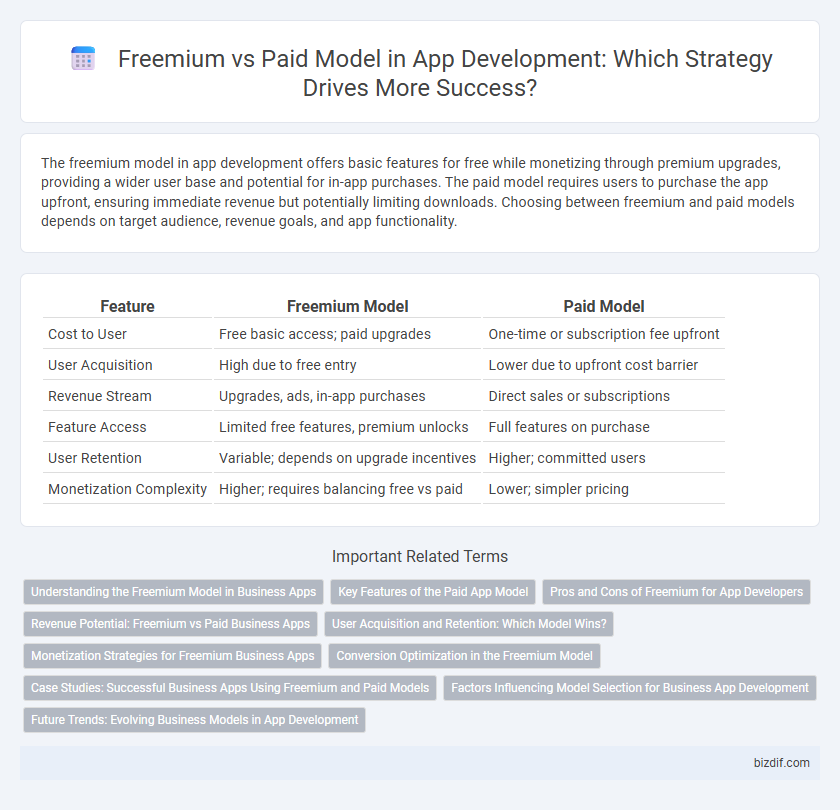The freemium model in app development offers basic features for free while monetizing through premium upgrades, providing a wider user base and potential for in-app purchases. The paid model requires users to purchase the app upfront, ensuring immediate revenue but potentially limiting downloads. Choosing between freemium and paid models depends on target audience, revenue goals, and app functionality.
Table of Comparison
| Feature | Freemium Model | Paid Model |
|---|---|---|
| Cost to User | Free basic access; paid upgrades | One-time or subscription fee upfront |
| User Acquisition | High due to free entry | Lower due to upfront cost barrier |
| Revenue Stream | Upgrades, ads, in-app purchases | Direct sales or subscriptions |
| Feature Access | Limited free features, premium unlocks | Full features on purchase |
| User Retention | Variable; depends on upgrade incentives | Higher; committed users |
| Monetization Complexity | Higher; requires balancing free vs paid | Lower; simpler pricing |
Understanding the Freemium Model in Business Apps
The Freemium model in business apps offers core features for free while charging for advanced functionalities, driving user acquisition and engagement without upfront costs. This approach leverages large user bases to convert a percentage into paying customers through premium subscriptions or in-app purchases. Effective implementation requires balancing free offerings to showcase value while incentivizing upgrades to maximize revenue and user satisfaction.
Key Features of the Paid App Model
The paid app model offers exclusive features, ad-free experiences, and priority customer support, ensuring enhanced user satisfaction and engagement. Users benefit from full access to premium functionalities without limitations, fostering increased app retention and loyalty. Developers gain a predictable revenue stream, facilitating continuous updates and quality improvements.
Pros and Cons of Freemium for App Developers
The Freemium model enables app developers to attract a broad user base by offering free access with optional premium features, increasing user engagement and potential revenue through in-app purchases. This approach reduces entry barriers and facilitates rapid market penetration, but it risks lower upfront revenue and dependency on a small percentage of paying users to sustain profitability. Developers must balance feature limitations and monetization strategies to convert free users without alienating the broader audience.
Revenue Potential: Freemium vs Paid Business Apps
Freemium business apps generate revenue by offering basic features for free while monetizing premium features through subscriptions or in-app purchases, attracting a larger user base and increasing conversion opportunities. Paid business apps rely on upfront purchases, ensuring immediate revenue but potentially limiting user acquisition due to price barriers. Analyzing user engagement metrics and lifetime value reveals that freemium models often yield higher cumulative revenue over time compared to paid models in competitive app markets.
User Acquisition and Retention: Which Model Wins?
The freemium model drives higher user acquisition by offering free access with optional in-app purchases, attracting a broader audience. Paid models tend to generate stronger user retention due to perceived value and commitment from upfront investment. Data from app analytics reveals freemium apps achieve 3x more downloads, while paid apps report 40% higher 30-day retention rates.
Monetization Strategies for Freemium Business Apps
Freemium business apps generate revenue by offering core features for free while unlocking advanced functionalities, premium content, or enhanced user experiences through in-app purchases or subscriptions. Monetization strategies include tiered subscription plans, feature gating, and targeted ads integrated seamlessly to maximize user engagement and conversion rates. This approach balances wide user acquisition with scalable income streams, leveraging data analytics to optimize pricing and feature offerings.
Conversion Optimization in the Freemium Model
Conversion optimization in the freemium model centers on enhancing user engagement and strategically unlocking premium features to maximize upgrades. Leveraging in-app analytics and personalized onboarding funnels improves the likelihood of free users transitioning to paid subscribers. Effective use of A/B testing on pricing, feature availability, and user interface elements drives higher conversion rates within the freemium app development framework.
Case Studies: Successful Business Apps Using Freemium and Paid Models
Spotify exemplifies the successful freemium model by offering free access with ads and premium features through subscription, driving over 456 million users and $13 billion in revenue in 2023. In contrast, Minecraft's paid model generated $415 million in revenue by charging upfront, ensuring steady income from dedicated players. These case studies highlight the freemium approach's scalability through user acquisition and the paid model's advantage in securing immediate, predictable revenue.
Factors Influencing Model Selection for Business App Development
Factors influencing the selection between freemium and paid app development models include target audience behavior, revenue goals, and market competition. Businesses analyzing user engagement metrics and willingness to pay can optimize monetization strategies while balancing user acquisition costs. Technical scalability and long-term maintenance expenses also play critical roles in deciding the most suitable app pricing approach.
Future Trends: Evolving Business Models in App Development
Freemium and paid models are evolving with the rise of subscription services and in-app purchases, shifting towards hybrid monetization strategies that maximize user retention and revenue generation. Advanced analytics and AI-driven personalization enable developers to tailor experiences, increasing conversion rates from free to premium users. Future trends indicate a growing emphasis on value-based pricing and continuous feature updates to sustain long-term engagement in competitive app markets.
Freemium vs Paid Model Infographic

 bizdif.com
bizdif.com